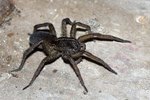
The cane spider is known by different names in different regions, including brown huntsman, large brown spider, banana spider and giant crab spider. They're found in subtropical climates, and may have came to the U.S. as stowaways in banana shipments from Central America. They don't weave webs, instead stalking their prey, capturing and holding it with their large, powerful fangs.
Physical Description
Cane spiders are large, flat-bodied arachnids with two rows of eyes and long, hairy legs. Their bodies are about an inch long, with a leg span that reaches up to 5 inches wide. Cane spiders are brown, with a cream-colored band encircling the top of their backs, and black bands or spots on their legs. Male cane spiders have pale patches behind their eyes and longer legs than females, while females have larger abdomens.
Habitat
Cane spiders are found in Hawaii, Florida, Georgia, Alabama, Louisiana, Texas, California, Southeast Asia, Australia and the Caribbean. They frequent sugar cane fields, avocado and banana groves and forests, hiding in tree holes and under bark. Cane spiders can't tolerate cold temperatures. Their flat bodies fit in tiny cracks, enabling them to find their way into homes, heated garages, outbuildings and greenhouses to keep warm.
Reproduction
Cane spiders breed year-round. After mating, the female spins a white egg sac surrounding approximately 200 eggs. She carries her egg sac under her body, causing her to be mostly immobile. In about three weeks, the mother tears open the egg sac and pale baby spiders emerge. The mother spider stays with the babies for several weeks after they hatch. The babies will molt several times during this period. Cane spiders live for more than 2 years.
Cane Spiders and Humans
Cane spiders are nocturnal, entering homes and hiding behind wall hangings and under furniture, coming out at night to hunt. They are found in cars, often behind sun visors, frightening humans with their large size. Cane spiders are reluctant biters, biting only if provoked. Their bites are small but painful. They do not produce enough venom to be dangerous to humans, but a headache may result. Some cultures welcome the cockroach-eating cane spiders into their homes.
References
Photo Credits
-
Ablestock.com/AbleStock.com/Getty Images
Writer Bio
Karen Mihaylo has been a writer since 2009. She has been a professional dog groomer since 1982 and is certified in canine massage therapy. Mihaylo holds an associate degree in human services from Delaware Technical and Community College.



